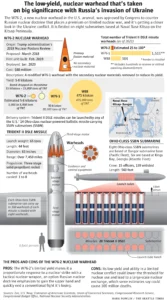 America’s 14 Trident subs, 8 operating in the Pacific out of Bangor, Washington, and 6 in the Atlantic, are now armed with some low-yield “tactical” warheads.
America’s 14 Trident subs, 8 operating in the Pacific out of Bangor, Washington, and 6 in the Atlantic, are now armed with some low-yield “tactical” warheads.
This warhead, dubbed the W76-2, has about one-third to one-half the explosive power of the Hiroshima and Nagasaki bombs.
Described as “Trump’s most ambitious nuclear decision,” the W76-2 seems tailor-made for the Ukraine crisis. It’s “not designed to be a city destroyer … its utility in the conflict in Ukraine is to respond if Russia uses a small nuke first.”
It was developed in 2018 as a response to a Russian strategy described in the 2018 Nuclear Posture Review, an official document, that relies “on threats of limited nuclear first use, or actual first use, to coerce us, our allies, and partners into terminating a conflict on terms favorable to Russia.” This strategy is called “escalate to de-escalate,” meaning using escalating a conventional conflict to a limited nuclear attack in order to force the West to back down and agree to Moscow’s terms.
(click on image to enlarge)
It would most likely come into play if Russia was losing a conventionally-fought war: “Based on Putin’s doctrine, Pentagon leaders worry Russia could resort to using nuclear weapons, especially the low-yield variety, if its conventional forces fall behind in the fight. Potential adversaries, like Russia, believe that employment of low-yield nuclear weapons will give them an advantage over the United States and its allies and partners,” a Trump administration defense official said in 2020.
This is where the W76-2 comes in. “The warhead provides the U.S. a quick-response option if Russia uses a nuclear weapon first, and reassures allies … that they’re well protected by the U.S. arsenal.” But the weapon’s critics, who include Rep. Adam Smith (D-WA), “worry that its utility in responding to a limited nuclear strike would quickly escalate into a full-blown nuclear war.”
This story originally ran in the print edition of the Seattle Times on Saturday, March 12, 2022 (starting on the front page, and continuing on p. A6); read the online version here. (Seattle Times articles are behind a paywall, with a limited number of free articles; if you can’t access it, there’s another online version here.)
I’m not the only person who thinks Russia’s attack on Ukraine could escalate into World War 3 (see Forbes article here). President Biden has openly spoken of that risk; it’s why the U.S. and NATO won’t directly intervene to help Ukraine, or impose a no-fly zone over Ukraine. On Friday, Russia warned it may attack NATO’s supply lines to stop the flow of Western arms to Ukrainian defenders (see story here), which isn’t surprising as those weapons are killing Russian troops.
It’s easy to see how this conflict could blow up into a far bigger war.
In Scenario A, Russian forces encircle Kyiv, facing dug-in defenders, and rather than take high casualties in house-to-house fighting, Putin decides to blow up the entire city and all the Ukrainian fighters inside it with a nuke. In Scenario B, he decides to nuke an airport or arms depot in Poland or Romania.
In either case, the U.S. and NATO are presented with a fearsome dilemma. A deterrent doesn’t deter unless you’re willing to use it, and they don’t retaliate for a Russian nuclear attack, that would invite nuclear blackmail and convince Putin he can safely conduct more nuclear attacks. But if tit-for-tat ensues, and nothing breaks the chain of escalation (which would require one side to back down), eventually cities would become targets.
This article describes what might happen on the U.S. side in a nuclear war, although some of its contents refer to capabilities still in development. Meanwhile, this article argues U.S. presidents shouldn’t have unilateral authority to launch nuclear attacks, with Trump specifically in mind should he return to office in 2025.
Related: This is “rally ’round the flag time,” and with Russia now attacking Ukrainian cities and killing civilians (an inevitable byproduct of war), few Americans are in a mood to consider Putin’s point of view. (Note: The U.S. and its allies bombed and leveled cities, and killed vast numbers of civilians, in World War 2.) This book does — and argues this didn’t have to happen. (So does this article.) To which I respond, maybe, but it’s too late now to revisit our policy mistakes (if any). By now, you probably realize this isn’t just about Ukraine. The book blurb says, “Vladimir Putin swears that Washington betrayed a promise that NATO would move ‘not one inch’ eastward and justifies renewed confrontation as a necessary response to the alliance’s illegitimate ‘deployment of military infrastructure to our borders.’” Putin’s war aim is to install a Moscow-controlled regime in Kyiv to prevent Ukraine from joining NATO or seeking closer European ties.